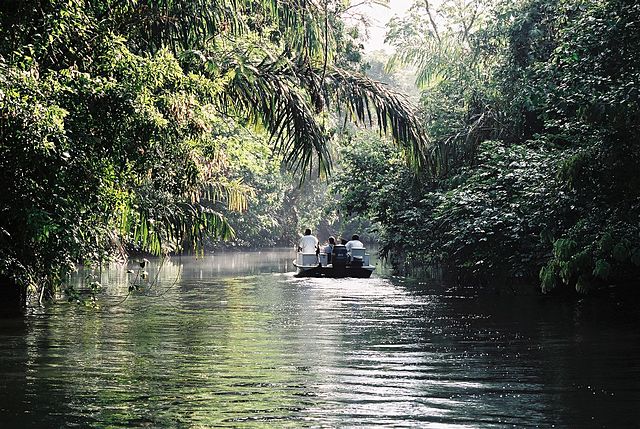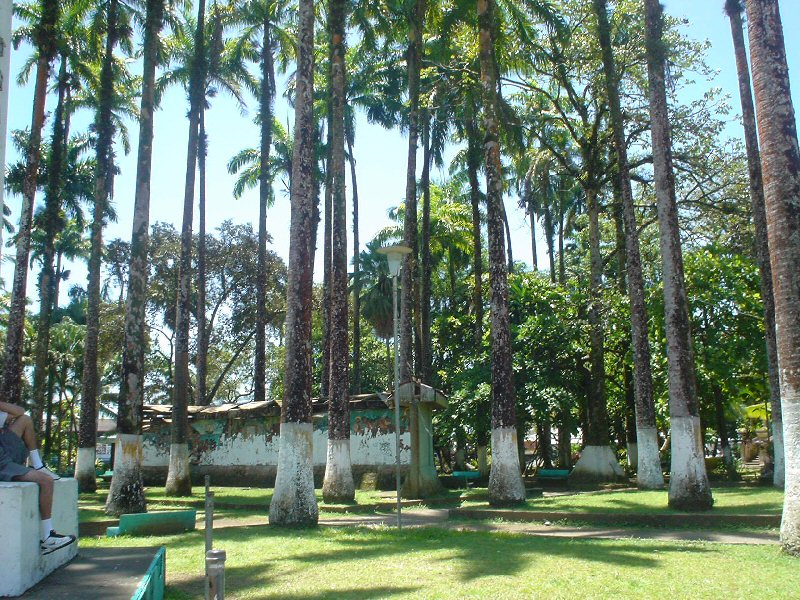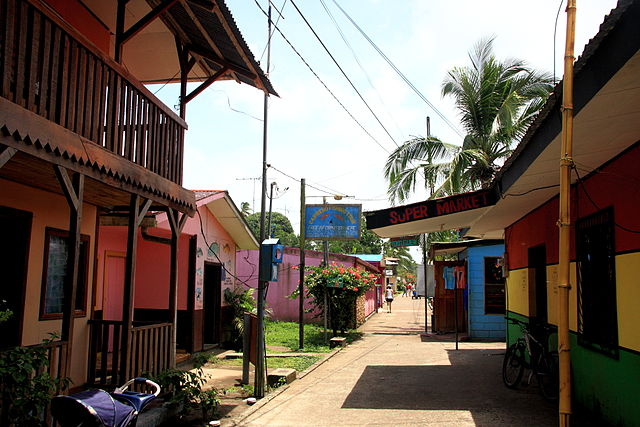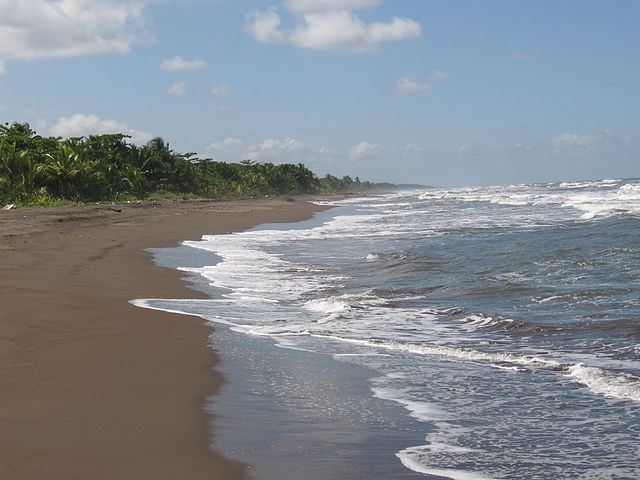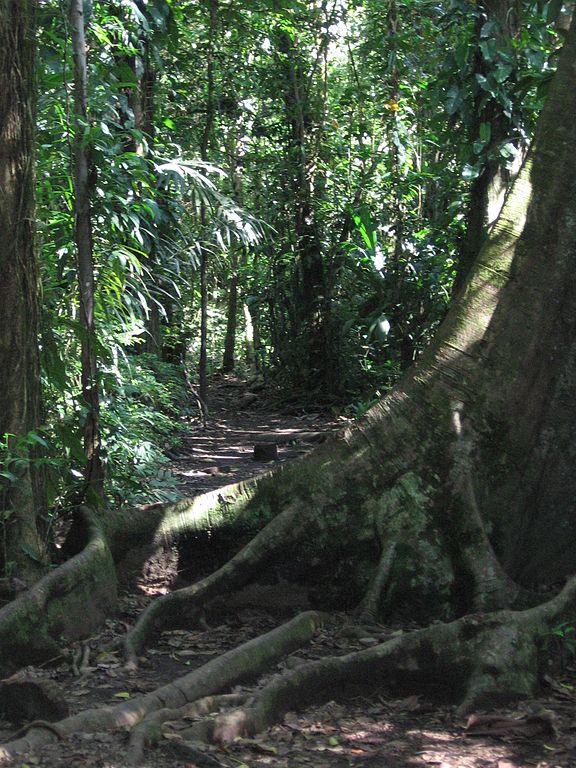
Puerto Limon
The overland road ends on the Caribbean coast at Puerto Limon. Today the city has 55,000, mostly African American, inhabitants, but it is honored as the birthplace of Costa Rica’s “white” history. In 1502, Christopher Columbus landed on the small offshore island of Uvita, dropped anchor and went ashore in the belief he had arrived at the Kingdom of Siam. Columbus named the island La Huerta, “The Orchard,” after the lush green land on the opposite shore. Isla Uvita is now a protected historic area, reachable from Puerto Limon by boat. It has trails that take the visitor around its rugged stone cliffs and caves.
The Costa Rican government made Porto Limon the capital of the 9,000square-kilometer Limon Province in 1872, just two years after the beginning of construction on the Atlantic Railway. The move was in anticipation of its future role as a port for shipping coffee to Europe. Contrary to their expectations, the city developed into a center for industry, oil refineries and banana transport. Soon the harbor proved to be too shallow for modern freighters.
Destinations in Puerto Limon
Aviarios del Caribe, Selva Bananito
Around the turn of the century the government began construction of a new harbor, seven kilometers further north at Bahia Moin. At that time the city began its slow decline into poverty. It was accelerated in the 1950s when banana exports drastically declined.
The colorful mansions in the former center, with their fanciful wrought-iron balconies, are falling to ruin. The onetime docks are deserted and covered with piles of rubbish. Vultures, lazy from the midday heat, pick at garbage in the streets. The city has still not recovered from its most recent blow, delivered by the earthquake of 1991. Broad cracks in the buildings, broken sidewalks and streets, as well as the tectonically raised coral reef, now used as a garbage dump by the residents, give the city a dismal and forlorn appearance nearly a decade after the catastrophe.
The lemon tree that gave the city its name in the last century is long dead. It once stood in front of the Alcaldia, the bright, stucco-decorated city hall, which remains a beautiful example of Caribbean tropical architecture, featuring wide balconies, open arcades and bay windows. The city, which was originally founded in a swampy area plagued by yellow fever and then moved to higher ground, still wakes up early in the morning. Most residents try to accomplish their tasks before noon in order to escape the merciless heat of the afternoon. They allow themselves a long relaxing siesta after lunch. The shops and bars remain open until late into the night. Some local residents pass seamlessly from siesta to fiesta. The two top meeting places in town are the lively Caribbean Market (Avenida 2, Calle 3-4) and the Parque Vargas, a miniature jungle complete with vines, waving palm and banyan trees and bushy bromeliads. The park displays a bust of Christopher Columbus and his son Fernando erected in 1990, commemorating their landing on the nearby island of Uvita in 1502. Another bust shows Balvanera Vargas Molina, the governor at the turn of the century.
Even though Puerto Limon has few tourist attractions to speak of, it is still interesting and worth visiting because of its people. The inhabitants of the city are primarily black, the descendants of Jamaican slaves imported to work on Costa Rica’s banana plantations. Their Creole culture gives the city a unique character. It is especially apparent in their cuisine with its exotic dishes and drinks, in their reggae and calypso music, and in their popular medicine which uses ancient herbs for healing a variety of ailments.
Pidgin English is spoken on the Costa Rican Caribbean coast rather than Spanish. When you greet one of the many Rastafarians with their shoulder-length dreadlocks on the streets of Puerto Limon, a greeting is more often “all right,” than “hello,” and instead of “good bye” they are more likely to say “okay.” But this is only scratching the surface of the Creole culture in Puerto Lim6n.
Increasing tourism in the past few years has raised the living standard of the inhabitants, and at the same time, accelerated their assimilation into the Spanish dominated Costa Rican culture.
The contrast between the different worlds of the poor and unemployed native inhabitants and the casual, strolling, and comparatively well-to-do vacationers is hard to ignore.
Once a year, however, the residents of Puerto Limon forget their problems for the week leading up to October 12, the anniversary of the discovery of America. For an entire week they celebrate the Limon Carnival. The pulsating rhythms of reggae, salsa and calypso music reverberate through the streets and alleys. The Indians join in with tribal dances that have been all but forgotten. Even the Chinese living in Puerto Limon join in the lively festivities.
The people paint themselves from head to toe, and this could just as well be New Orleans or Trinidad. For visitors it is important to realize that Puerto Limon and its people have to be accepted totally, the good along with the darker side of their make up. It is all or nothing, and those who cannot accept this vibrant culture are better off leaving for other parts of the country.
TOWNS AND BEACHES AROUND PUERTO LIMON
Four kilometers north of Puerto Lim6n (toward Moin) are two small beaches. Playa Bonita has a fine yellow sand beach with palm trees, passable hotels, but not ideal water conditions. Playa Portete has a dock for local fishermen who land here with their catches. Further north is the tiny village of Moin, where the government built an industrial harbor for freight ships in the 1980s. Here crude oil arrives in huge tankers for the refineries further inland, and bananas are packed into containers for transport to Europe and the United States.
Traveling north along the canals, that were so popular with tourists before the 1991 earthquake, you arrive after about 50 kilometers at a small town at the mouth of the Rio Parismina. The village, also named Parismina, is well known among sport fishermen for its two excellent fishing lodges. Deep-sea fishing enthusiasts from all over the world come here to catch tarpon and snook in the turquoise waters of the Caribbean. The lodges rent out fishing rods, and sell fishing accessories and bait.

